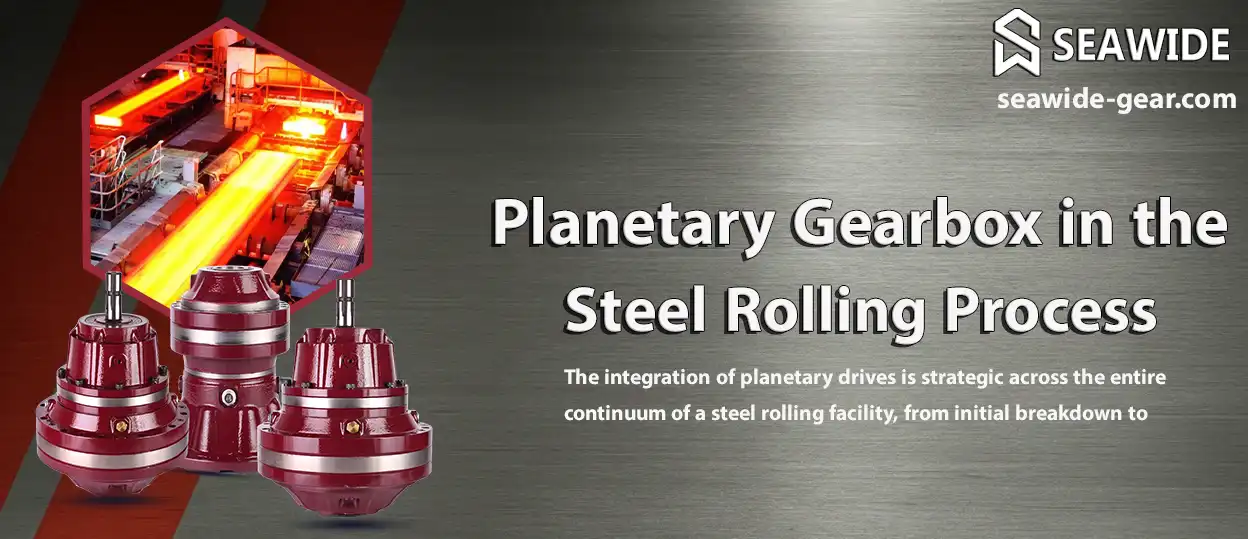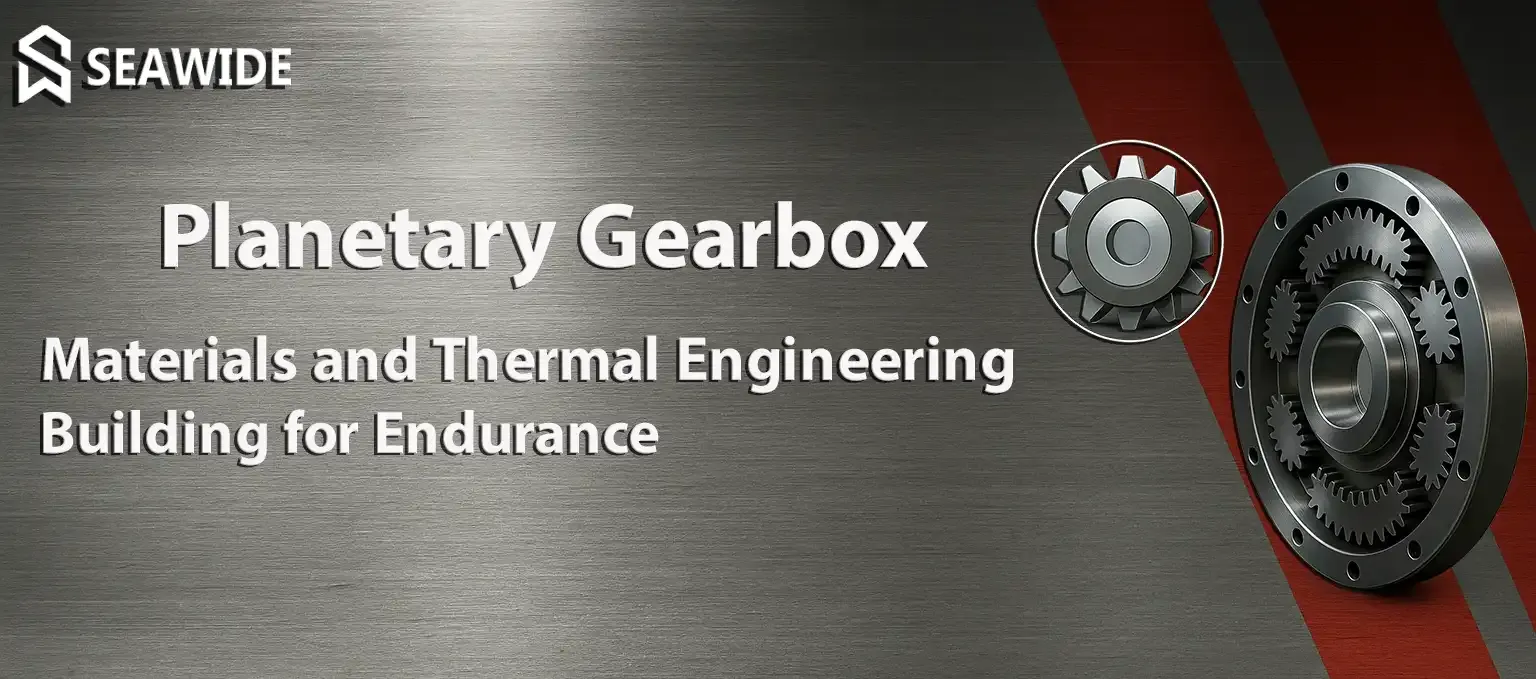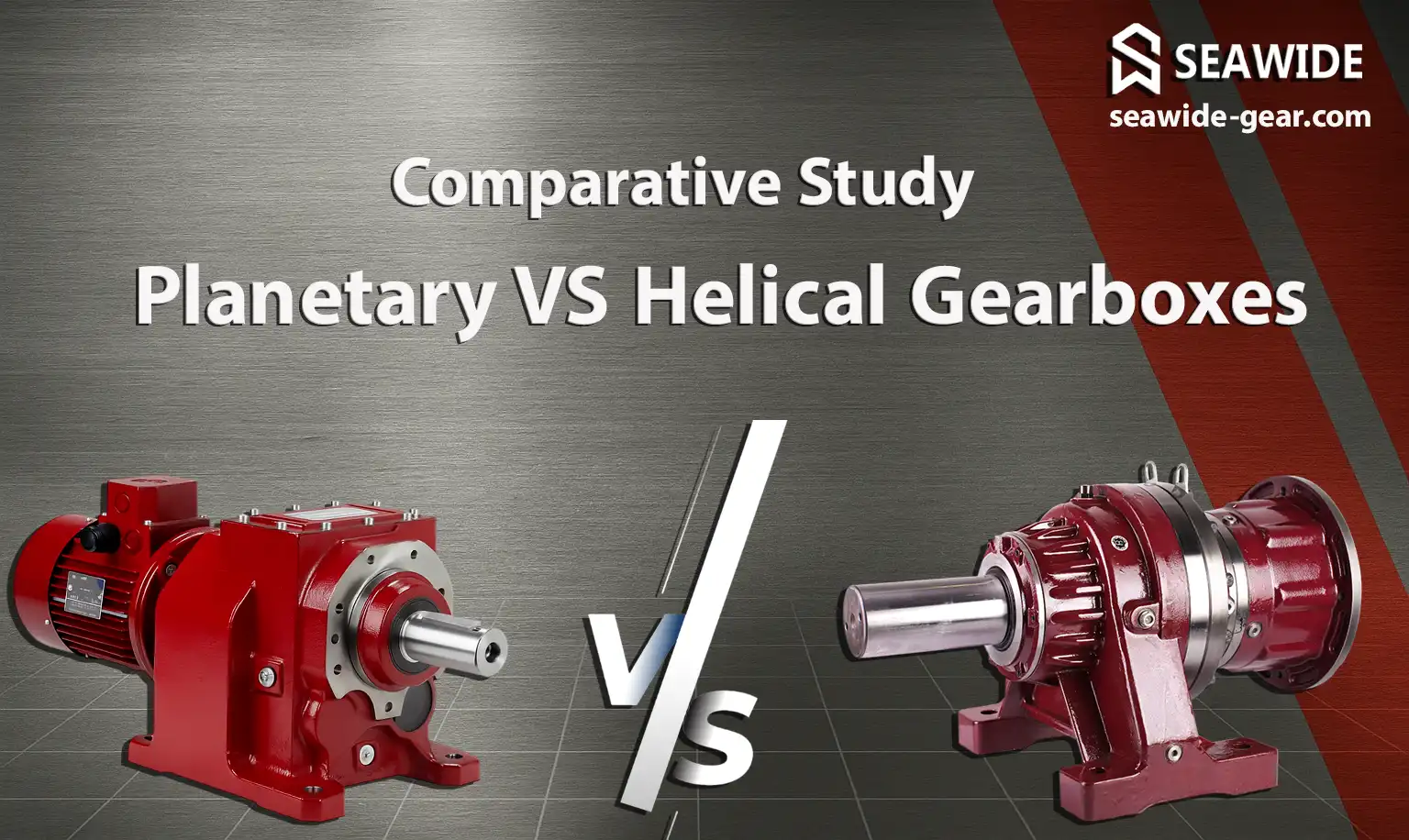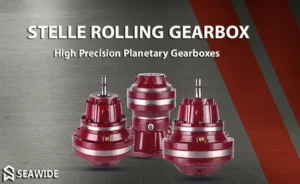Steel Rolling Gearbox: High Precision Planetary Gearboxes
A Comprehensive Pillar SEO Article by Seawide‑Gear.com
Introduction: The Critical Role of Gearboxes in Steel Rolling

In the demanding environment of steel rolling mills, where high torque, continuous operation, and precision synchronization define profitability, the gearbox becomes the silent powerhouse of mechanical endurance. The process of transforming massive steel ingots or slabs into precise sheets, bars, or coils involves immense mechanical work. Torque demands fluctuate dramatically, particularly during the transition between roughing and finishing passes, often involving immediate, high‑impact load reversals.
Among the available technologies, the planetary gearbox has emerged as the preferred solution for steel rolling applications. Its unique construction offers inherent advantages over traditional parallel‑shaft or bevel gear arrangements when confronting the stringent requirements of metallurgical processing. The primary benefits—a compact structure, exceptionally high efficiency, and superior load‑sharing mechanism—deliver unmatched torque density, which is vital for powering the main drives in roughing, intermediate, and finishing stands, as well as the heavy tension requirements of coiler drives.
Modern steel rolling lines, often running 24 hours a day, seven days a week, require motion transmission systems that can manage heavy dynamic loads, thermal expansion, and contamination from process water and scale without failure. For mill operators, the gearbox must ensure consistent rolling speed and torque control to maintain sub‑millimeter gauge tolerances in finished steel products. Here, the planetary system proves superior by facilitating multi‑planet load distribution and minimizing operational backlash, directly impacting final product quality. Any measurable lag or deflection translates directly into non‑conforming product, leading to significant material waste and reprocessing costs. The robust nature of the planetary design ensures that these performance parameters are maintained over millions of operational cycles.
Fundamental Design of Planetary Gearboxes
A planetary gearbox, formally known as an epicyclic reducer, relies on a highly efficient, centralized mechanical arrangement. The core components consist of:
- A central Sun Gear: This is the input or output hub, typically connected to the motor or the main work roll.
- Multiple Planetary Gears: These gears mesh with both the sun gear and the ring gear. In heavy‑duty applications like steel rolling, three or four planets are standard, ensuring balanced load distribution.
- An Outer Ring Gear (Annulus): This fixed or rotating gear contains internal teeth that mesh with the external teeth of the planetary gears.
- A Planet Carrier: This structure holds the planetary gears on their respective shafts (or pins) and acts as the input or output element, depending on the configuration.
This architecture allows power to be distributed simultaneously across several meshing points. This fundamental principle of simultaneous engagement is the source of the system’s remarkable performance metrics: higher torque capacity, improved efficiency (consistently reaching 97–98% in high‑precision units), and reduced overall vibration due to the inherent balancing effect.
Key Mechanical Advantages for Steel Applications:
- Torque Multiplication: The planetary arrangement divides the transmitted torque across all engaged planets. This load sharing enables torque transmission capacities up to three times greater than that achievable by a standard, similarly sized parallel‑shaft or helical reducer, making them ideal for the high reduction ratios needed in rolling mills.
- High Power Density: The inherent coaxial layout allows for an extremely compact footprint relative to the torque it transmits. This high power density is crucial for retrofitting older mills or integrating drives into tight spaces within modern, space‑constrained mill stands.
- Coaxial Design: The input and output shafts are aligned along the same central axis. This feature drastically simplifies alignment procedures, reducing installation time and minimizing shaft bending stresses when coupling directly to heavy roll spindles or high‑power motors.
Planetary gearboxes specifically engineered for heavy steel rolling are designed to accommodate significant dynamic loading profiles, often handling input speeds ranging from 1,000 to 3,000 rpm while generating output torques that frequently exceed 150,000 Nm in finishing stand applications. To manage the heat and shock inherent in steel production, advanced forced oil circulation systems and robust bearing arrangements are mandatory to ensure smooth operation under sudden shock loads encountered during mill startups or emergency braking sequences.
Planetary Gearbox in the Steel Rolling Process

The integration of planetary drives is strategic across the entire continuum of a steel rolling facility, from initial breakdown to final coil tensioning.
Read more information about Smelting and metallworking on Wikipedia
3.1. Application Zones within the Mill
Steel rolling lines are typically segmented based on the severity of reduction required:
- Roughing Stands (Stands R1–R3): These stands apply the largest torque demands to break down thick slabs. Planetary gearboxes here are sized for maximum endurance and shock absorption, often requiring multi‑stage reduction (3 to 5 stages) to achieve necessary torque amplification at relatively low output speeds.
- Intermediate and Finishing Stands (Stands F1–F6): Precision is paramount here. The gearbox must maintain speed synchronization within tight tolerances to achieve the final required gauge thickness (e.g., within $\pm 0.01$ mm). The low backlash of the planetary system is critical for these high‑precision control loops.
- Coiler Sections: Tension control in the coiler drives requires smooth acceleration and deceleration profiles. Planetary units manage the high inertia of the incoming strip, ensuring that the coil is wound evenly without stretching or damaging the material.
- Ancillary Equipment: They are also utilized in descaling, pinch roll assemblies, and walking beam furnaces where reliable, low‑speed, high‑torque delivery is necessary.
Operational Challenges and Mitigation
Rolling mills expose gearboxes to an exceptionally harsh operational envelope, characterized by:
- High Mechanical Stress: Cyclical overloading and reverse torque.
- Thermal Extremes: Rapid temperature swings from ambient to high operational temperatures (lubricant temperatures can spike rapidly).
- Contamination: Exposure to rolling emulsions, scale dust, and abrasive particles carried by cooling water spray.
The robust, sealed housing design of modern planetary systems acts as the first line of defense. Mitigation strategies implemented by Seawide include:
- Forced Oil Circulation: A pumped lubrication system circulates oil through external heat exchangers, actively removing heat and maintaining lubricant integrity. This is essential because high temperatures rapidly degrade the additive package and reduce the load‑carrying capacity of the oil.
- Advanced Sealing: Utilizing triple labyrinth seals and specialized lip seals on input/output shafts prevents the ingress of fine scale particles and cooling water, which are primary causes of bearing and gear premature failure.
Planetary Gearbox Supplier | Gearbox for Sale & price-SEAWIDE
Precision Control and Responsiveness
The inherent mechanical stiffness of the planetary design yields very low torsional windup, which translates into superior dynamic performance.
Backlash specifications for high‑end steel rolling gearboxes must be extremely low. While standard industrial gearboxes might tolerate 8–15 arcminutes, planetary units used in precision finishing lines achieve backlash figures as low as 1–3 arcminutes. This stiffness is crucial for digital control systems:
[ \text{Torsional Rigidity} \propto \frac{1}{\text{Backlash}} ]
A lower backlash ensures that commanded angular movement from the servo motor results in immediate, proportional movement at the roll face. Furthermore, integration with digital torque transducers and high‑speed servo inverters allows for the implementation of predictive maintenance algorithms based on subtle shifts in torque ripple signatures, indicating developing tooth wear or bearing instability.
Materials and Thermal Engineering: Building for Endurance

The lifespan of a gearbox operating under continuous high load is dictated almost entirely by the quality of its material science and thermal management.
Material Selection and Tooth Geometry
For the extreme contact stresses and shock loads encountered in steel rolling, standard commercial steels are insufficient. Case‑carburized alloy steels are universally employed for the primary load‑carrying components:
- Gears (Sun, Planet): Materials like 18CrNiMo7‑6 or high‑grade 20MnCr5 are used. These steels allow for a hard, wear‑resistant surface case depth (typically 1.5 to 2.5 mm) while retaining a ductile, shock‑absorbing core.
- Ring Gears: Often manufactured from high‑strength forged alloy steel blanks. To achieve the necessary surface hardness and tooth profile accuracy, the ring gear teeth are typically induction‑hardened or flame‑hardened on the flanks to achieve hardness levels up to 58–62 HRC, resisting pitting and scoring.
Achieving the full potential of these materials requires high‑precision finishing. Gear manufacturing quality is often benchmarked using the DIN (Deutsches Institut für Normung) standard. Planetary drives for high‑end steel rolling target accuracy levels of DIN 4 or better (AGMA Q12+ equivalent). This precision grinding minimizes surface irregularities, which drastically reduces friction, noise, and transmission losses.
Bearing Technology and Load Distribution
The bearings supporting the planet pins and the main input/output shafts bear significant combined radial and axial forces.
- Planet Bearings: Tapered‑roller bearings are often preferred for planet shafts as they handle high radial loads while accommodating the minor inherent eccentricity of the planet cluster movement.
- Shaft Bearings: High‑capacity spherical or cylindrical roller bearings support the main housing structure, designed for long life under variable axial thrust generated by bevel contact or gear separation forces.
The bearing arrangement must be optimized to distribute the load evenly across all planetary journals. When properly sized and maintained, these systems are engineered to achieve a Mean Time Between Failures (MTBF) exceeding 60,000 operational hours in continuous service.
View information about Planetary Gearboxes related to the Smelting and Metallurgy industry
Thermal Design: Controlling the Heat Curve
Continuous high‑speed operation generates substantial frictional heat. If lubricant temperature exceeds $80,^\circ\text{C}$, the rate of oxidation accelerates significantly, causing rapid oil degradation and premature component wear.
Seawide’s advanced planetary units integrate sophisticated dual circulation cooling systems:
- Mechanical Churning: Oil is circulated within the gearbox housing by the rotation of gears and carriers.
- Forced Flow Cooling: An external gear pump draws oil from the sump and pushes it through high‑efficiency, finned heat exchangers (oil-to-water or oil‑to‑air).
This active temperature management is a key differentiator. By maintaining the bulk lubricant temperature consistently below the $80,^\circ\text{C}$ threshold, the effective lubricant service life is extended, and component life expectancy is often improved by up to 25% compared to systems relying only on natural heat dissipation or basic splash lubrication.
Comparative Study: Planetary vs. Helical Gearboxes

The selection between different gearbox types is a critical engineering decision in mill design, directly impacting CAPEX, OPEX, and product quality. The table below summarizes the functional trade‑offs for steel rolling duty:
ParameterPlanetary Gearbox (Epicyclic)Helical / Bevel Gearbox (Parallel Shaft)Torque DensityVery high (up to 3× higher per volume)MediumEfficiency97–98% (Due to fewer meshing contacts per reduction stage)92–94% (Higher sliding friction losses)Size & WeightExtremely Compact, Lighter relative to torqueBulky, heavier footprintBacklash (Precision)Excellent (1–3 arcmin achievable)Good to Moderate (6–10 arcmin typical)Maintenance FrequencyLow (Extended oil change intervals)Moderate (Requires more frequent inspection of shaft alignment)Shock ResistanceHigh (Load shared across multiple points)Average (Concentrated load on fewer teeth)Torsional RigidityExcellent (Crucial for closed‑loop control)GoodCost per $\text{Nm}$ (Lifecycle)Lower (Due to energy savings and longevity)Higher (Higher replacement/energy costs)
From an operational viewpoint, the planetary gearbox offers undeniable advantages in efficiency, maintenance reduction, and process accuracy. While the initial capital expenditure might be marginally higher for ultra‑high precision planetary units, lifecycle cost analysis (LCA) consistently demonstrates that the superior energy utilization and reduced unscheduled downtime result in a significantly lower total cost of ownership, especially in high‑throughput, continuous 24/7 steel mill operations.
Energy Efficiency and Smart Integration
In contemporary steel production, where electricity often constitutes the largest operational cost, optimizing energy consumption is paramount. The inherent efficiency advantage of the planetary gearbox translates directly into substantial financial savings.
Seawide Gear’s specialized planetary series has demonstrated verified energy savings exceeding 9.2% across continuous rolling campaigns when replacing older, less efficient parallel shaft units. This gain stems from:
- Triple‑Load Sharing Design: Maximizing the utilization of the gear train components while minimizing localized friction points.
- High‑Precision Ground Gear Teeth (AGMA 12+): Minimizing parasitic friction losses caused by geometric imperfections.
- Optimized Lubrication Paths: Designing sumps and flow dynamics to reduce churning losses—the energy wasted simply by the gears churning the oil mass.
Smart Integration and Digitalization
Efficiency gains are now being maximized through the integration of the Industrial Internet of Things (IIoT) and advanced sensor technology. Planetary gearboxes are increasingly becoming data nodes within the mill’s supervisory control and data acquisition (SCADA) system.
Integrated vibration, temperature, speed, and torque sensors feed live operational data into cloud‑based analytical platforms. Artificial Intelligence (AI) models process this data to establish a baseline of “healthy” operation. Deviations, such as a slight increase in harmonic content on the 2X RPM vibration frequency, can predict bearing cage failure weeks in advance. This shift to Predictive Maintenance (PdM) drastically reduces catastrophic failures, contributing to an estimated 18% reduction in unscheduled downtime annually across mills utilizing this level of monitoring.
Seawide Gear Advantage: Precision Engineering at Scale
Seawide Gear has strategically positioned itself to serve the highly technical demands of the global steel industry by focusing on quality consistency and responsive service delivery.
Cost Efficiency and Global Quality Benchmarks
A key differentiator for Seawide is the ability to manufacture planetary gearboxes that adhere to stringent German engineering tolerances (DIN/AGMA standards) while providing a competitive global price point. We achieve an estimated up to 30% cost advantage compared to legacy European and Japanese OEMs. This cost efficiency is realized through streamlined, digitized manufacturing workflows and massive economies of scale in high‑volume production.
- In‑House Capabilities: Full control over the manufacturing process, from forging preparation to final grinding, within our state‑of‑the‑art CNC machining and heat‑treatment facilities, guarantees strict tolerance control.
- Agile Supply Chain: Recognizing that time off‑line equates to massive revenue loss for steel producers, Seawide has optimized logistics. Standard delivery times for custom units have been reduced from the industry average of 14–16 weeks to a target of 6–8 weeks for most rolling mill requirements.
Custom Engineering for Steel Rolling Demands
Steel processing lines are never identical. Seawide approaches gearbox supply as an engineering partnership, offering highly modular configurations:
- Versatile Ratios: Support for single‑stage ratios up to 10:1, or multi‑stage arrangements capable of achieving overall reduction ratios spanning from 3:1 up to an immense 500:1.
- Integrated Solutions: Optional integrated components, including heavy‑duty torque reaction arms, fluid coupling interfaces, and pre‑plumbed forced lubrication and cooling kits, ensure the gearbox arrives ready for bolt‑on installation, minimizing site integration complexity.

Proven Performance Metrics
Our commitment is validated by installation records across diverse heavy industry sectors. Seawide planetary drives are currently operating reliably in over 120 active steel processing plants globally.
Case Study Snapshot: A recent high‑throughput retrofit on the main drive of a 600,000 Tons Per Annum (TPA) hot strip mill yielded measurable benefits:
- Energy Savings: Documented annual energy consumption reduction of €18,000 for that single stand.
- Noise Reduction: Operational noise levels at the drive station decreased by 7 dB(A) due to the smoother running characteristics of the precision ground gears.
- Vibration Control: Overall vibration amplitude, measured via accelerometers, was reduced by 15%, indicating a healthier mechanical system and extending the life of coupled components (motors, couplings, foundations).
These objective metrics underline Seawide’s philosophy: delivering world‑class longevity and measurable operational improvements.
Maintenance, Lifecycle, and Sustainability
The ultimate measure of a gearbox’s value is its operational lifespan and the cost incurred during that time. For high‑duty planetary systems, maintenance shifts from reactive replacement to proactive condition management.
Seawide mandates and supports an integrated Condition‑Based Maintenance (CBM) program tailored to the environment:
- Scheduled Oil Analysis: Quarterly or semi‑annual sampling to monitor lubricant health (viscosity change, particulate contamination (PQ Index), and wear metal particle count (ICP analysis)). Elevated iron or chromium levels signal incipient gear or bearing wear.
- Borescope Inspections: Non‑invasive visual checks of gear flanks and bearing races during planned maintenance shutdowns to quantify wear progression before it becomes critical.
- Dynamic Balancing and Alignment Checks: Periodic dynamic balancing verification for high‑speed rotating elements (carriers) and precise re‑alignment of input/output shafts every 10,000 operational hours to counteract structural settling or foundation shift.
By rigorously adhering to these CBM protocols, mill operators can reliably extend the expected service life of major internal components (gears and bearings) by over 20%, often pushing overhaul intervals beyond the 10‑year mark in moderate duty cycles.
For a complete review of industrial equipment related to Smelting and Metalworking, click here.
Sustainability Commitment
In addition to improving customer efficiency, Seawide is committed to sustainable manufacturing. This includes prioritizing the use of highly recyclable materials (high‑grade steel alloys), minimizing scrap rates through advanced CNC programming, and designing gearboxes for easier disassembly and component refurbishment, reducing the overall environmental footprint associated with heavy equipment lifecycle management.
Internal Linking Opportunities for Content Clusters
To build authority and guide users deeper into Seawide’s technical offerings, this pillar page should interconnect with specialized sub‑topics crucial for gearbox management:
- Lubrication Management in Heavy‑Duty Gearboxes: (Deep dive into synthetic vs. mineral oils, additive packages for extreme pressure/temperature).
- Advanced Heat Treatment for Gear Durability: (Detailed comparison of carburizing vs. nitriding for rolling mill applications).
- Noise & Vibration Diagnostics in Planetary Systems: (Focus on spectral analysis techniques for early fault detection).
- IoT Integration for Predictive Maintenance: (Technical specifications for sensor integration and data output formats compatible with standard MES/SCADA systems).
- Precision Surface Finishing and Its Effect on Efficiency: (In‑depth look at the geometric accuracy standards like DIN 4 grinding and ISO P standards).
Each linked article should maintain a highly technical, informative tone, specifically targeting mechanical engineers, lead maintenance technicians, and corporate procurement decision‑makers responsible for capital investment in mill drive systems.
Conclusion: Driving the Future of Steel Rolling
The modern steel industry demands efficiency, uptime, and unrelenting precision. In this complex landscape, the planetary gearbox has firmly established itself as the superior core technology for mechanical power transmission. Its compact architecture, market‑leading torque density, and inherent low backlash make it indispensable for achieving the tight tolerances required by high‑speed, automated rolling mills.
Seawide Gear does not merely supply components; we deliver precision, engineered reliability, and measurable performance gains. Our planetary gearbox series represents the fusion of advanced material science, meticulous manufacturing accuracy, and a customer‑centric service model designed to optimize your operational expenditure.
Need a high‑efficiency gearbox engineered precisely for your rolling line’s torque and speed demands?
Explore customized planetary solutions built to exceed OEM standards at https://seawide‑gear.com or connect directly with our technical consultation team for an immediate engineering assessment.



